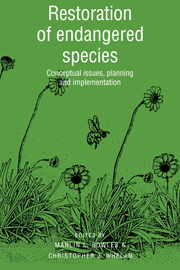Foreword
Published online by Cambridge University Press: 27 January 2010
Summary
Restoration ecology is a rapidly growing and intellectually exciting field devoted to the challenging, if not unattainable, task of fixing damaged ecosystems or reestablishing components of ecosystems. The field's vitality is reflected in the founding of the Society for Ecological Restoration in 1987, and more recently, with the launching of its new journal, Restoration Ecology. Ecological restoration is not, however, without its frustrations. Mistakes could be devastating, leading ultimately to the extinction of a species. Unfortunately, restoration ecology is likely to become increasingly difficult in the future, as more species and the ecosystems in which they live are threatened. Despite the relative youth of the field of restoration ecology, an appraisal of its present state can benefit practitioners and students alike. We view this book as an attempt to examine a broad range of issues involved in the process of species restoration. The issues range from the political to the biological, from the theoretical to the practical, from planning and managing restoration efforts to monitoring restored populations.
Most of the authors contributing to this book first presented their work at a Symposium on the Recovery and Restoration of Endangered Plants and Animals organized for the Second Annual Conference of the Society for Ecological Restoration, held in Chicago, Illinois in 1990. We organized the symposium to provide a forum for government representatives, conservationists, and biologists to share ideas, recent findings, techniques, and future concerns.
- Type
- Chapter
- Information
- Restoration of Endangered SpeciesConceptual Issues, Planning and Implementation, pp. xi - xiiPublisher: Cambridge University PressPrint publication year: 1994



